1.04.2025

On April 29, 2025, Arianespace will launch Biomass, the European Space Agency’s Earth Explorer satellite with a Vega C rocket.
The Biomass mission is designed to deliver crucial information about the state of our forests and how they are changing, and to further our knowledge of the role forests play in the Earth’s carbon cycle.
As the launch service provider, Arianespace contributes to Europe’s autonomous access to space, enabling ESA to carry out a critical mission in environmental monitoring and climate research.
Quelle: arianespace
+++
Biomass satellite to lift off aboard Vega C in late April

On Tuesday, April 29, 2025, at 6:15 a.m. local time (09:15 a.m. UTC, 11:15 a.m. CEST), Arianespace will launch ESA's Biomass Earth Explorer satellite aboard a Vega C rocket from Europe's Spaceport in French Guiana. Designated flight VV26, the mission aims to deliver the satellite into a Sun-Synchronous Orbit approximately 666 kilometers above Earth. The satellite will separate from the launcher 57 minutes after lift-off.
The European Space Agency's Earth Explorer program is renowned for producing world-class scientific data on Earth's dynamic systems. Forests, which absorb about 8 billion tonnes of carbon dioxide annually, play a critical role in climate regulation. However, deforestation and degradation, particularly in tropical regions, are reversing this benefit by releasing stored carbon back into the atmosphere. Gaining a comprehensive understanding of this process is key to assessing broader climate impacts.
Biomass is equipped with the first P-band synthetic aperture radar ever flown in space. With a wavelength of roughly 70 centimeters, the radar can penetrate dense forest canopies, allowing it to assess forest structure and measure carbon content. The mission will monitor forest height and biomass distribution over time, offering valuable insight into carbon storage and ecological changes.
Beyond tracking forest biomass, the satellite will also provide data on subsurface geological formations in deserts, internal ice sheet structures, and forest floor topography. Built by Airbus Defence and Space, Biomass is designed for a mission duration of at least five years. During this period, it will observe a minimum of eight forest growth cycles.
These comprehensive measurements will not only enhance understanding of the global carbon cycle but also shed light on habitat loss rates and their potential effects on forest biodiversity.
Quelle: SD
----
Update: 12.04.2025
.
Biomass fully loaded
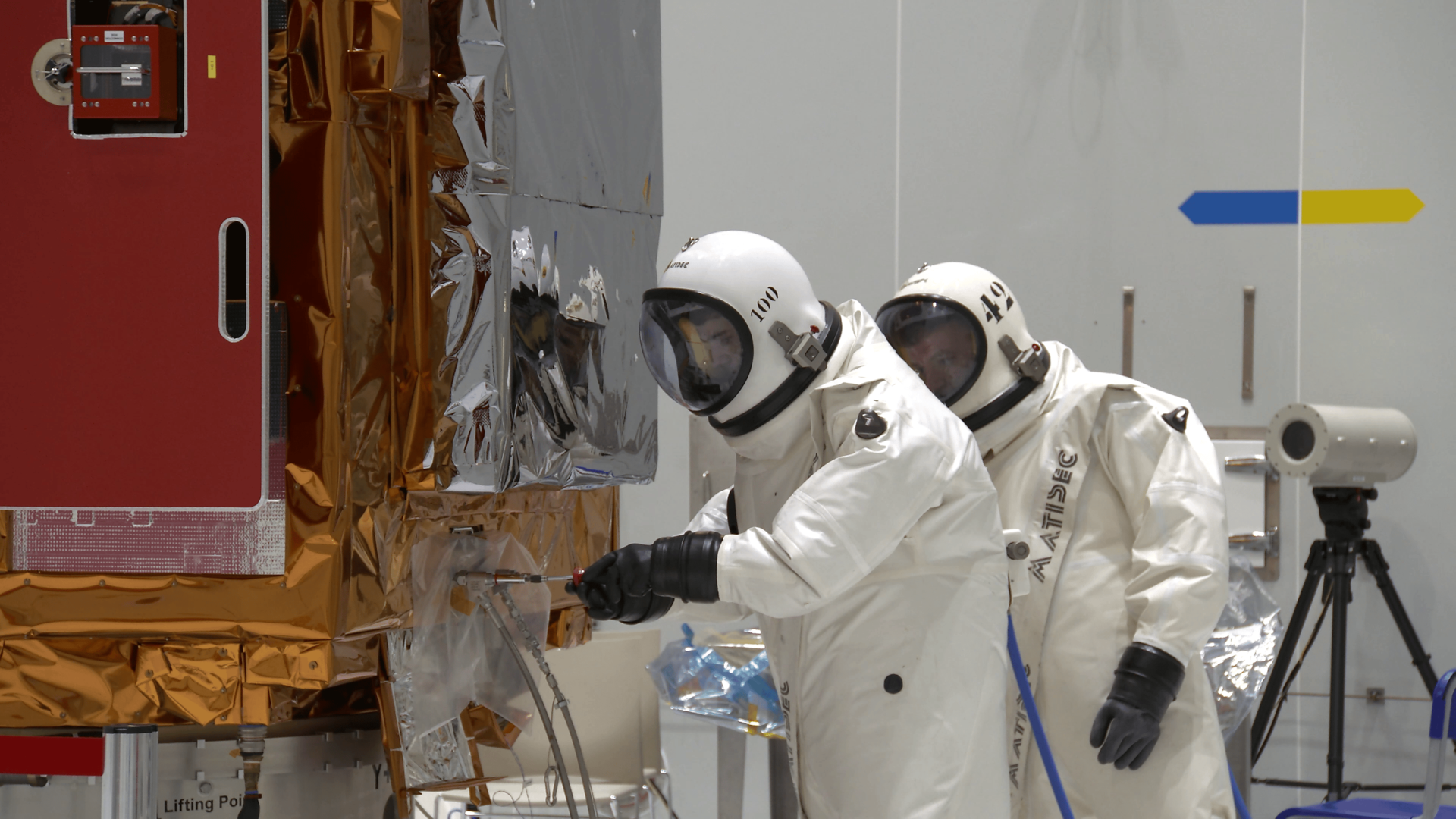
Marking a major milestone in the preparation of ESA’s Biomass satellite for its scheduled 29 April liftoff, experts have completed the critical and hazardous process of fuelling the satellite.
Once launched and commissioned for its working life in orbit around Earth, this new ESA Earth Explorer mission will demonstrate how new technology can deliver crucial information about the state of our forests and how they are changing and, importantly, further our knowledge of the role forests play in the carbon cycle.
The satellite has been at Europe’s Spaceport in French Guiana since 10 March being tested and ready for liftoff on a Vega-C rocket on 29 April.
A hazardous process

The latest milestone on the checklist was the precise and delicate process of loading the satellite with 132 kg of highly volatile fuel. This fuel will power the satellite so that it can carry out the complex manoeuvres that are needed to collect crucial data on our forests.
The ‘Biomass rocks and rolls’ video below highlights these orbital manoeuvres.
ESA’s Project Manager for Biomass, Michael Fehringer, said, “Preparations to ready our satellite for launch have been going very well here at Europe’s Spaceport in Kourou and I thank everyone involved.
“Fuelling the satellite is extremely hazardous and was carried out by the highly specialised team from European-Astrotech-Ltd. Everyone else had to leave the cleanroom while this was happening for safety reasons.”
Stefan Kiryenko, ESA Launch Campaign Manager, noted, “I’m happy to add that everything went according to plan and Biomass is now fully loaded. The next step is to mate it to the launch adapter and then encapsulate it within the Vega-C rocket fairing.”
Detecting biomass in forests

Biomass is the first satellite to carry a P-band synthetic aperture radar – an innovative instrument capable of penetrating forest canopies to measure the woody trunks, branches and stems where carbon is primarily stored.
This cutting-edge technology will provide an unprecedented wealth of data, enabling scientists to accurately assess forest carbon stocks and fluxes influenced by land-use changes, forest degradation and regrowth.
In turn, it will enhance our understanding of forest health, track changes over time, and address key uncertainties in the complex carbon cycle.

Access the video
Forests play a crucial role in regulating atmospheric carbon dioxide through photosynthesis, storing carbon in their trunks, branches, leaves and roots.
However, significant uncertainties remain about the total carbon stored in the world’s forests and how these stocks are evolving. Rising temperatures, increasing atmospheric carbon dioxide levels and human activities, such as deforestation for agriculture and urban expansion, further complicate this dynamic.
ESA’s Biomass mission aims to resolve these uncertainties by delivering critical data on carbon stocks and fluxes. By tracking carbon shifts linked to land use, degradation and regrowth, the mission will deepen our understanding of the role of forests the global carbon cycle.
Biomass is scheduled to launch on 29 April at 11:15 CEST (06:15 Kourou time).
Quelle: ESA
----
Update: 19.04.2025
.
Forest mission sealed within rocket fairing for liftoff

With the launch of ESA’s Biomass satellite scheduled for 29 April, preparations at Europe’s Spaceport in Kourou, French Guiana, have reached a key milestone. The satellite has now been sealed inside the protective fairing of the Vega-C rocket – now hidden from view, the satellite is almost ready for its journey into space.
Once in orbit, this latest Earth Explorer mission will provide vital insights into the health and dynamics of the world’s forests, revealing how they are changing over time and, critically, enhancing our understanding of their role in the global carbon cycle.
Biomass, an ESA Earth Explorer research mission, has been at the spaceport since March undergoing a series of final tests and preparations for liftoff on a Vega-C rocket on 29 April at 11:15 CEST.
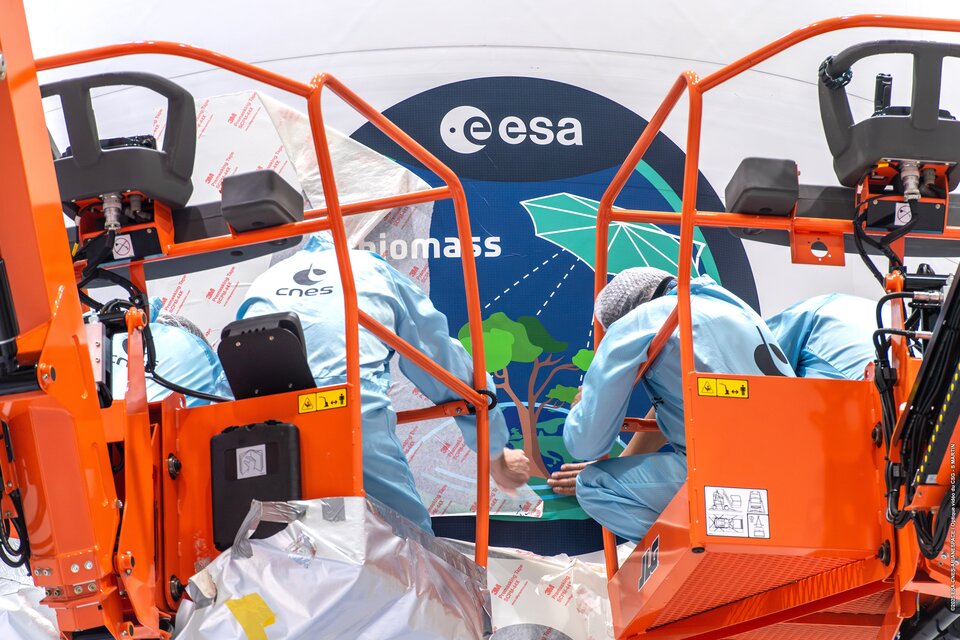
Most recently, the team completed the hazardous task of fuelling, followed by mounting the satellite onto the rocket’s launch adapter.
Umbilical harnesses were connected and tested to ensure a secure electrical interface, and the satellite was successfully powered on for pre-launch system checks.
Engineers also carried out electrical tests on the launch vehicle’s own systems to verify smooth integration with the satellite.
Meanwhile, the Vega-C fairing half-shells, already sporting the mission patch and partner stickers, were transferred into the facility for encapsulation.
The fairing shields the satellite during ascent into space.
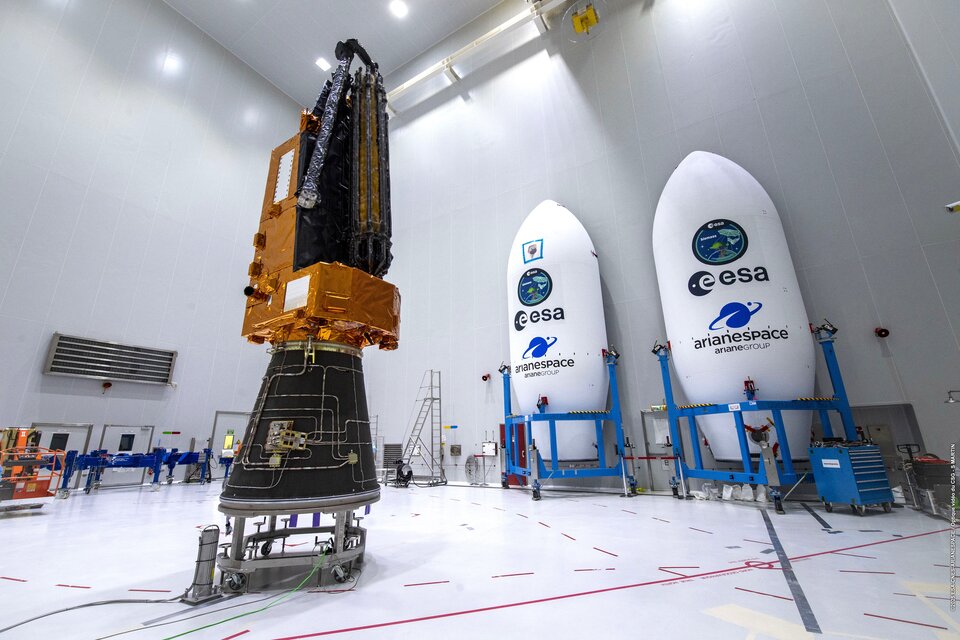
ESA Assembly, Integration and Verification Engineer, Gianluigi Fava, said, “Encapsulating a satellite inside a rocket fairing is always a deeply emotional moment for the team. After years of development, building, testing and dedication, it’s the last time we’ll ever see the satellite with our own eyes.”
ESA’s Biomass Project Manager, Michael Fehringer, added, “But the real farewell comes at launch. That’s when we watch all our hard work lift off into space – knowing that our precious satellite is on its way to begin delivering vital data about Earth’s forests and their role in the carbon cycle, and hence climate system. We’re incredibly proud and excited for what lies ahead.
“We’re deeply grateful to the many people who have worked tirelessly to make this mission possible – from those helping bring the satellite to life on the ground, to the teams preparing to operate it in orbit, and the scientists ready to turn its data into meaningful insights.”
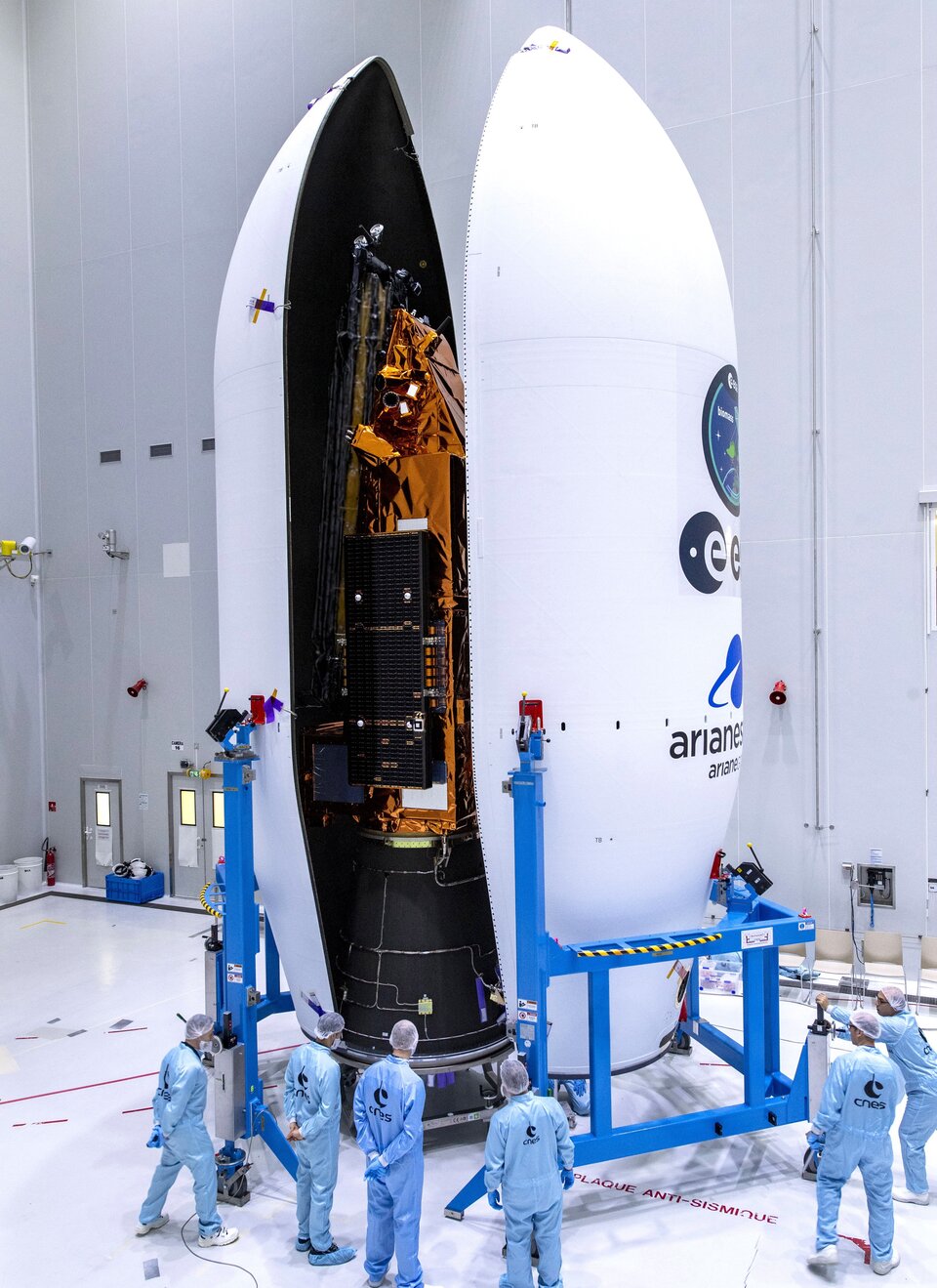
Biomass is the first satellite to carry a P-band synthetic aperture radar – an innovative instrument capable of penetrating forest canopies to measure the woody trunks, branches and stems where carbon is primarily stored.
This cutting-edge technology will provide an unprecedented wealth of data, enabling scientists to accurately assess forest carbon stocks and fluxes influenced by land-use changes, forest degradation and regrowth.
In turn, it will enhance our understanding of forest health, track changes over time, and address key uncertainties in the complex carbon cycle.
Forests play a crucial role in regulating atmospheric carbon dioxide through photosynthesis, storing carbon in their trunks, branches, leaves and roots.

However, significant uncertainties remain about the total carbon stored in the world’s forests and how these stocks are evolving. Rising temperatures, increasing atmospheric carbon dioxide levels and human activities, such as deforestation for agriculture and urban expansion, further complicate this dynamic.
ESA’s Biomass mission aims to resolve these uncertainties by delivering critical data on carbon stocks and fluxes. By tracking carbon shifts linked to land use, degradation and regrowth, the mission will deepen our understanding of the role of forests in the global carbon cycle.
Biomass is scheduled to launch on a Vega-C rocket on 29 April at 11:15 CEST (06:15 Kourou time).

Europe’s Vega-C rocket is the evolution of the Vega family of rockets and delivers increased performance, greater payload volume and improved competitiveness.
Complementing the Ariane family to launch all types of payloads into their desired orbits, Vega-C ensures that Europe has versatile and independent access to space.
ESA owns the Vega-C programme, working with Avio as prime contractor and design authority.
Quelle: ESA
----
Update: 29.04.2025
.
Biomass launched to count forest carbon
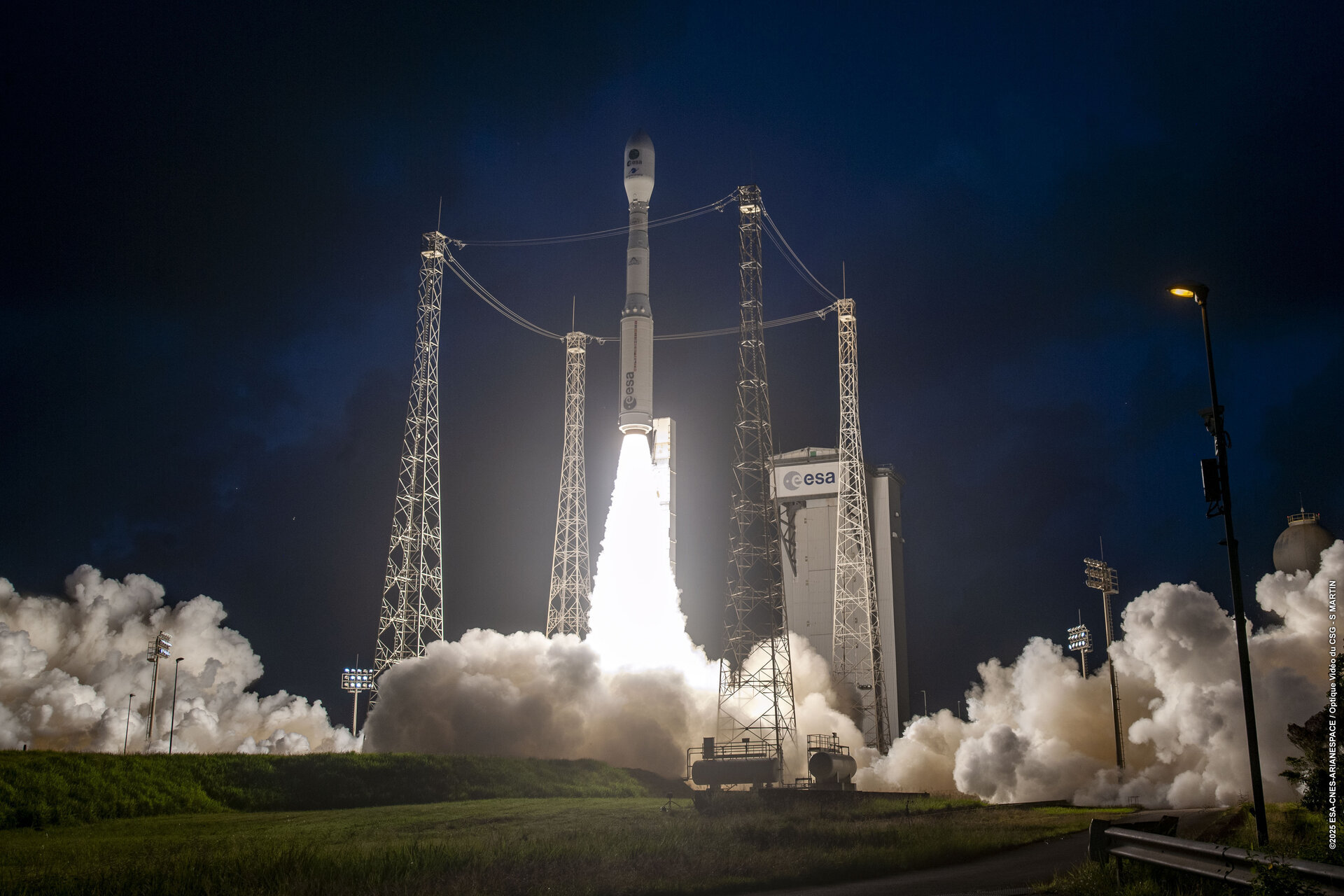
ESA’s groundbreaking Biomass satellite, designed to provide unprecedented insights into the world’s forests and their crucial role in Earth’s carbon cycle, has been launched. The satellite lifted off aboard a Vega-C rocket from Europe’s Spaceport in Kourou, French Guiana, on 29 April at 11:15 CEST (06:15 local time).


Access the video
Less than an hour after launch, Biomass separated from the rocket’s upper stage. At 12:28 CEST, the satellite controllers at ESA’s European Space Operations Centre in Germany received the all-important first signal, relayed via the Troll ground station in Antarctica, that Biomass is working as expected in orbit.


Access the video
Controllers will spend the coming days carrying out the ‘launch and early orbit’ phase, meticulously verifying that all systems are functioning correctly.
This critical phase also involves a series of intricate manoeuvres to deploy the satellite’s 12-metre-wide mesh reflector supported by a 7.5-metre boom. Once this phase is complete, Biomass will join the portfolio of pioneering missions operated from ESA's mission control centre.

Carrying the first P-band synthetic aperture radar in space, the Biomass mission is designed to deliver crucial information about the state of our forests and how they are changing, and to further our knowledge of the role forests play in the carbon cycle.
ESA’s Director of Earth Observation Programmes, Simonetta Cheli, said, “I’d like to extend my congratulations to everyone who has been involved in developing and launching this extraordinary mission. Biomass now joins our esteemed family of Earth Explorers – missions that have consistently delivered groundbreaking discoveries and advanced scientific understanding of our planet.
“With Biomass, we are poised to gain vital new data on how much carbon is stored in the world’s forests, helping to fill key gaps in our knowledge of the carbon cycle and, ultimately, Earth's climate system.”

Forests play a vital role in Earth’s carbon cycle by absorbing and storing large amounts of carbon dioxide, helping to regulate the planet’s temperature. Often called ‘Earth’s green lungs’, they absorb around 8 billion tonnes of carbon dioxide annually. However, deforestation and degradation – especially in tropical regions – are releasing stored carbon back into the atmosphere, worsening climate change.
A major challenge for scientists and policymakers is the lack of accurate data on how much carbon forests store and how these stocks are changing owing to factors such as rising temperatures, increasing atmospheric carbon dioxide levels, and human-driven land-use changes.

Biomass is the first satellite equipped with a P-band synthetic aperture radar, which is capable of penetrating forest canopies to measure woody biomass – trunks, branches, and stems – where most forest carbon is stored. These measurements act as a proxy for carbon storage, the assessment of which is the mission’s primary goal.
Data from Biomass will significantly reduce uncertainties in carbon stock and flux estimates, including those related to land-use change, forest loss, and regrowth.
About Biomass
ESA’s Biomass forest mission uses advanced space technology to provide new data on forests and their changes. It enhances our understanding of forests’ roles in the carbon cycle and climate. Its P-band radar penetrates clouds and forest layers, scattering signals off forest elements. These signals reveal details like forest biomass and height. Biomass data will improve knowledge of habitat loss and its effects on biodiversity. The mission also enables the mapping of subsurface geology in deserts, ice sheet structures, and forest floor topography.
The satellite was developed by over 50 companies led by Airbus UK.
About Vega-C
Europe’s Vega-C rocket can launch up to 3300 kg into space, including small scientific and Earth observation satellites. At 35 m tall, Vega-C weighs 210 tonnes on the launch pad and reaches orbit with three solid-propellant-powered stages before the fourth liquid-propellant stage takes over for precise placement of satellites into their desired orbit around Earth. Vega-C is the evolution of the Vega family of rockets and delivers increased performance, greater payload volume and improved competitiveness.
Quelle: ESA
